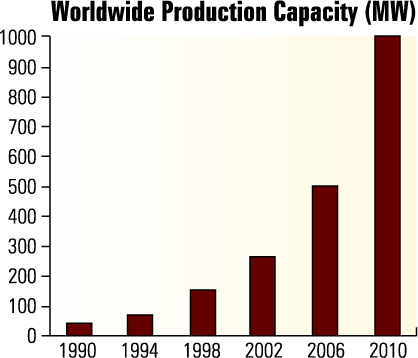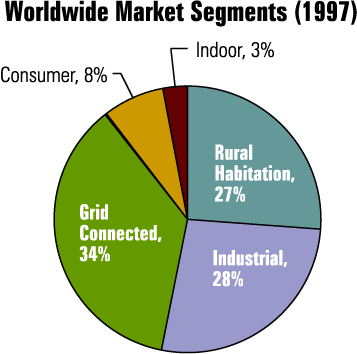Siemens Solar Panels direct from
Bullnet

|
 |
 |
 |
|
How big is the photovoltaic market
and how fast is it growing?
Current estimates of worldwide production of solar photovoltaic cells and modules for 1998 are about 120 megawatts (MW), up steadily and
dramatically from only 40 MW in 1990. Worldwide sales have been increasing at an average rate of about 15% every year during the last decade, although that growth rate has been slower in some markets and regions but faster in
others. We believe that there is a realistic possibility for the market to continue to grow at about a 15% rate into the next decade, At this rate, the world production capacity would be 1000MW by 2010, and photovoltaics could be a
$5 Billion industry. These are realistic benchmarks, and show the solar business to be a very exciting market opportunity in the near term. |
 |
|
|
 |
 |
|
|
Application Growth Forecasts
We turn our attention from general market forecasts to specific application areas to look at how photovoltaic power is used around the world. The application groups of
photovoltaic power can be divided into five broad groups:
|

|
- Industrial
: This has been the major application area for 30 years, including telecommunications, cathodic protection, telemetry,
navigational systems and other unmanned installations in harsh remote sites. The load demands are well known and the requirements for reliable power are the highest.
- Rural Habitation
: This segment includes applications that are typically inhabited, such as cabins, homes, villages, clinics, schools, farms, as well as individually powered lights and small appliances.
The load demands in this segment are not as well defined, and are more flexible.
- Grid Connected
: These systems are typically multi-kilowatt or megawatt scale systems that are directly connected to an existing power grid network. Electric power is generated only during
daylight hours, and is either consumed at the site of generation (as on commercial buildings) or is fed into the general utility grid system and consumed as a part of the normal power system. Small 1-5 kilowatt
rooftop systems can be located on top of individual homes, while larger systems can be associated with commercial or industrial buildings to offset their daytime lighting or air-conditioning loads. Large 100-500
kilowatt systems can be installed along utility feeder lines close to their full capacity to improve power quality and postpone rewiring or installing new larger transformers.
- Consumer / Indoor
: These products use photovoltaic cells to provide the small amount of power needed for small electronic devices such as watches and calculators, as well as individually powered garden
lights, small modules for portable computers and radios, and other applications.
|
|
|
